In-Depth
KubeCon 2025: Exploring the KubeCon Ecosystem, Part 2
KubeCon + CloudNativeCon North America 2025 provided a remarkable opportunity for me and other attendees to explore the full range of innovative technologies emerging within the cloud-native space. Both established industry leaders and ambitious startups were present, each offering unique perspectives and creative solutions. This diversity and ingenuity were clearly reflected in the Solution Showcase area, which features numerous booths representing a wide variety of technologies and approaches to solving issues in the Kubernetes (K8s) and cloud-native ecosystem.
In the first part of this two-part article, I recapped a roundtable I attended and provided an overview of Komodor, one of the standout companies I had the opportunity to engage with during the event. In this second part, I focus on other companies I had the chance to speak with at KubeCon. At the end of this article, I will share my final thoughts on the conference.
To capture the breadth of innovation present at the event, I have selected a variety of organizations for discussion. These range from large multinational corporations, such as Nutanix and SUSE, which have demonstrated their leadership in the enterprise space, to smaller, specialized companies like Tailscale and Chronosphere, each offering focused and novel contributions to the cloud-native landscape. Through these highlights, I aim to convey the dynamic and collaborative spirit that defines KubeCon and the ongoing evolution of this ecosystem.
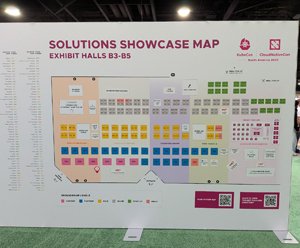 [Click on image for larger view.]
[Click on image for larger view.]
Chronosphere
Chronosphere, founded in 2019 by former Uber engineers Martin Mao and Rob Skillington, was created to tackle the challenges of monitoring large-scale, cloud-native environments. At the event, I had the opportunity to discuss Chronosphere with Martin.
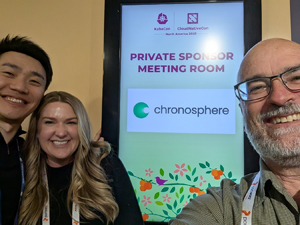 [Click on image for larger view.]
[Click on image for larger view.]
He said that it was built on their experience developing Uber's open-source metrics system, M3. Although it is currently headquartered in New York, it has a global engineering presence (Martin is just up the road from me in Seattle). He said that they are laser-focused on helping enterprises manage the cost, scale, and complexity of observability in Kubernetes and microservices ecosystems.
Tom's Tip - Observability is the ability to understand what's happening inside K8s clusters, applications, and infrastructure. It differs from Monitoring, which involves tracking known conditions using predefined metrics, logs, and alerts.
Martin explained that Chronosphere is a cloud-native observability platform that unifies metrics, traces, and logs into a single view, enabling teams to monitor performance and allowing their customers to troubleshoot issues faster, as it reduces data noise.
Key features include intelligent data control to limit unnecessary telemetry. It utilizes DDX, their advanced root-cause analysis tool, and Lens, a comprehensive management interface that supports open standards, including Prometheus and OpenTelemetry. The platform enables companies to reduce observability costs, enhance reliability, and scale seamlessly across modern, distributed systems.
What excited me about Chronosphere was its recent announcement of AI-Guided Troubleshooting capabilities, including a Temporal Knowledge Graph (TKG). It enables developers to maintain control by incorporating human oversight to resolve issues.
SUSE
SUSE presented me with a compelling story about its entry into the enterprise AI market as it builds on and is a targeted expansion of SUSE's core strengths in open-source and cloud-native technologies. Rather than being an embedded or SaaS-based AI solution, SUSE is focused on supporting organizations that need to build proprietary, secure AI environments. This is especially useful to those in regulated or IP-sensitive industries. They explain that a significant portion of Rancher (Which SUSE acquired a few years ago) customers are already running AI workloads, and SUSE is responding to the demand for a platform that supports custom-built, high-value AI systems without sending sensitive data to public LLMs.
 [Click on image for larger view.]
[Click on image for larger view.]
To meet this need, SUSE has developed a curated and observable AI platform that simplifies the fragmented AI tooling landscape, helping enterprises better utilize their costly GPU resources. Their curated AI library provides an integrated, fully supported stack of essential components. This ranges from inference engines to vector databases, while advanced observability capabilities, enhanced through their acquisition of StackState, give organizations deep insight into GPU consumption and workload distribution. Together, they said this helps their customers reduce complexity, accelerate development, and ensure their customers capture the full value of their AI investments.
Looking forward, SUSE stated that they are actively developing innovations to help enterprises manage emerging challenges, such as Model Context Protocol (MCP) sprawl.
Tom's Tip: MCP is an open standard that enables AI models, particularly with large language models (LLMs), to link securely and flexibly with external tools, data sources, and services. It aims to simplify and modularize the process of integrating AI systems with databases, APIs, and various other platforms. I think of it as a layer of abstraction.
Its forthcoming universal MCP proxy will centralize discovery, governance, and security across all MCP servers, while enabling legacy systems to integrate with modern LLMs and prevent proprietary data from leaving corporate boundaries. With this roadmap, SUSE is establishing a strategic new business line, offering a secure, sovereign AI foundation that helps enterprises build differentiated, mission-critical AI applications and maintain a long-term competitive advantage.
Devtron
I spoke with the team at Devtron, a Kubernetes management platform, on the second day of the conference. They said they differentiate themselves through a strategy of convergence, which eliminates the traditional separation between application and infrastructure operations. Their latest product, Devtron 2.0, unifies these domains into a single interface, allowing developers and operators to collaborate with shared context and consistent workflows.
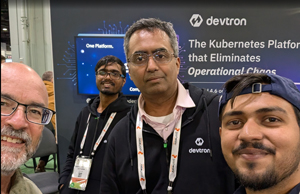 [Click on image for larger view.]
[Click on image for larger view.]
One of the new features in Devtron 2.0 is an AI-driven agentic worker that can detect infrastructure waste, recommend right-sizing actions, and automate fixes through pre-approved runbooks, helping organizations scale Kubernetes environments dramatically without expanding team size.
Their platform manages multi-cloud and multi-cluster environments through a cloud-agnostic control plane by integrating cloud with simple plugins.
The company's roadmap will extend its convergence further by unifying the management of both containers and virtual machines, aiming to become a true single pane of glass for all enterprise workloads.
Nutanix
I spent a lot of my time at KubeCon this year visiting with smaller startups. Still, I did make time to stop by Nutanix, a platinum sponsor of KubeCon, as I hadn't spent a lot of time lately looking into their Kubernetes story. In fact, the last time I looked into them, they were talking about Karbon (their Kubernetes product). After speaking with them, I discovered that Nutanix has undergone a significant evolution regarding Kubernetes, including expanding its scope and renaming its Kubernetes product.
 [Click on image for larger view.]
[Click on image for larger view.]
Nutanix's current Kubernetes integration is known as Nutanix Kubernetes Platform (NKP), which evolved from its earlier Karbon offering. It is designed to bring turnkey, enterprise-grade Kubernetes to on-prem, edge, and cloud environments. NKP is, of course, based on and tightly integrated with Nutanix's infrastructure stack (storage, compute, networking). NKP is designed to abstract away much of the operational burden and complexity associated with running Kubernetes. It leverages upstream, CNCF-conformant Kubernetes, which helps ensure portability, compatibility, and interoperability with open-source tooling.
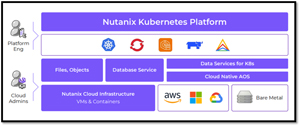 [Click on image for larger view.]
[Click on image for larger view.]
Looking under the hood of NKP, I found that it has a curated stack of CNCF and open-source projects. For networking, it features Cilium and Calico. For observability, NKP includes Prometheus, Thanos (for long-term, aggregated metric storage), and uses Grafana for visualizing metrics and logs. It supports Traefik for L7 ingress routing.
 [Click on image for larger view.]
[Click on image for larger view.]
Additionally, NKP utilizes Cluster API (CAPI), another CNCF project, for cluster lifecycle management and automation, providing a GitOps- and infrastructure-as-code-friendly control plane. The platform is organized into tiers (Starter / Pro / Ultimate), with higher levels including additional CNCF-compatible services such as service mesh, centralized logging, monitoring, policy, and multi-cluster fleet management.
Tailscale
I am a big fan and user of Tailscale's free VPN, so I was glad to have the opportunity to stop by and speak with them. They stated that their VPN has experienced unprecedented adoption, but they were attending KubeCon to talk about their Kubernetes story.
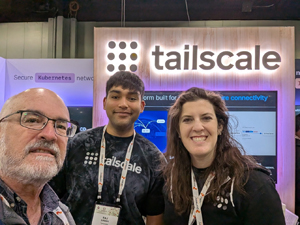 [Click on image for larger view.]
[Click on image for larger view.]
Tailscale offers a Kubernetes operator that brings its secure, WireGuard-based mesh network directly into a Kubernetes environment. Using this operator, they said that you can expose workloads inside a cluster to a Tailscale network (tailnet), set up egress so that pods can communicate with other tailnet devices, and even proxy the Kubernetes API server itself without exposing it to public internet access.
In addition, Tailscale's Kubernetes integration supports deploying subnet routers, exit nodes, and more via Kubernetes Custom Resources, allowing you to route entire IP subnets from Kubernetes into your tailnet. This approach provides customers with a secure, peer-to-peer connectivity model across on-premises, cloud, VMs, and containers, while maintaining strong access control through Tailscale's ACL system.
Final Thoughts
In my first article about this event, I covered the Day 0 pre-conference at KubeCon + CloudNativeCon North America 2025 in Atlanta. Which had several co-events hosted by the Cloud Native Computing Foundation, including the Red Hat OpenShift Commons Gathering and Google Container Day, both of which I was able to attend. Presentations at these events highlighted AI-driven tooling, such as built-in AI assistants for troubleshooting and automation, as well as some of the
significant enhancements in container and Kubernetes infrastructure from Google
, which showcased advancements like accelerated GPU provisioning, in-place pod resizing, dynamic IPAM, and advanced autoscaling.
My Day 1 Recap reported on how Kubernetes has become the foundational operating system for the AI era and how it is celebrating its 10-year milestone alongside the CNCF, which they proudly touted on the event's official T-shirt.
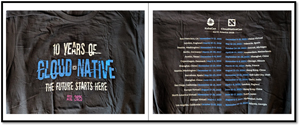 [Click on image for larger view.]
[Click on image for larger view.]
One of the highlights of the day was the announcement of the Kubernetes AI Conformance Program, designed to standardize AI/ML workloads across platforms. I was impressed hearing from Niantic and Scopely about how they utilize Kubernetes to run global Pokémon GO events, managing thousands of player interactions through machine-learning-powered models. Security was another key focus, with the CNCF pledging over $3 million to strengthen open-source supply chain resilience. This effort included introducing tools such as fault-injection testing via Antithesis and community auditing through OpenSSF and OSTIF.
On Day 2 of KubeCon + CloudNativeCon North America 2025, I appreciated how the keynotes grounded cloud-native and AI infrastructure in real-world impact, showcasing tangible IT wins rather than just hype. One standout talk was how OpenAI's Fabian Ponza shared how a single-line tweak to Fluent Bit saved them an astonishing 30,000 CPU cores by cutting CPU usage in half. From Airbnb's keynote, I learned that their engineers are now using AI coding tools not just for new features, but to modernize and maintain legacy systems. Perhaps most inspiring were the cloud-native-for-good stories, where organizations like the Child Rescue Coalition, the Red Cross, and the UN shared how they utilize CNCF projects to drive life-changing work, demonstrating that this technology isn't just powerful, but it can actually change human lives.
Nine years ago, when I attended KubeCon in Seattle (2016), I could hardly have imagined that it would grow and expand to what it is today. It has exceeded everyone's wildest expectations and dreams. This year's KubeCon was heavily focused on AI, both in its support and application, which is a good thing, as it shows that the conference is not getting stale but is dynamic and always searching for the next wave in IT.
 [Click on image for larger view.]
[Click on image for larger view.]
If you missed this event, KubeCon Europe will take place in Amsterdam next March, and next year, KubeCon North America will be held in Salt Lake City during the second week of November 2026.